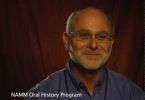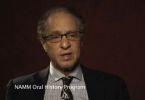Electronic Music
John Eaton spent the latter part of the 1960s composing for electronic musical instruments such as early synthesizers developed by Robert Moog and Paul Ketoff. His microtonal music included several works for live performances such as “Song for R. P. B” in 1964 in which John played the Syn-Ket and “...
Keith Emerson was the British rocker who in the early 1970s helped define live performances on electronic musical instruments such as the modular Moog. He gained fame as a musical composer and clever keyboardist for The Nice before forming Emerson, Lake & Palmer and recording a string of hits...
Larry Fast is best known as the innovative keyboardist and synthesizer composer who helped bring electronic musical instruments into pop music, beginning in the 1970s. His Synergy series of synthesizer music albums beginning in 1975 brought great popularity to the instruments, which were being...
David Cockerell designed one of the earliest synthesizers produced in the United Kingdom. The Synthi was introduced in the late 1960s by EMS Ltd. The unit, which came in a case with a KS keyboard, used patch cords to root reverb and ring modes. David also included two oscillators both with shape...
Allan Pearlman grew up in Queens New York and taught at a local high school after college before working in the music industry. In 1975, Sid Hack, hired Allan as a sales rep for Unicord, the same company his father, Ben, worked for 31 years. Allen loved the industry and continued to work for the...
Max Mathews was working as an engineer at the famed Bell Laboratory in 1954 when he was asked to determine if the computer Bell was designing could create music. The landmark Music 2 and later Music 4 projects put the two concepts together as early as 1957-–the computer and music had a future and...
Ray Kurzweil appeared on the popular 1950s and 1960s quiz show “I’ve Got a Secret” to reveal that he had made a computer that could make music. Since those early days, Ray has come to define the computer age of music making. Founder of Kurzweil Music, Ray designed some of the industry’s most noted...
John Worthington began as an engineer in the early days of the Musical Instrument Digital Interface (MIDI), and, in fact, helped program the MIDI time code. John also worked at Apple Computers during the company’s early involvement in computer music. His work led to the establishment of the music...
Leland Smith was the renowned founder of computerized musical notation. He came to symbolize the technological changes in print music beginning in the 1960s. His work as a professor and educator has resulted in a method for computers to read and process musical notes. The field of computer science...
Alan R. Pearlman was nicknamed “ARP” as a kid growing up in New York City, so it seemed the perfect name for a company when he was later designing electronic musical instruments. The first instrument created by Alan was the modular synthesizer known as the ARP 2500. The monophonic product was...









